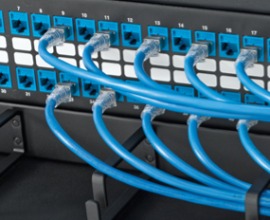Standards defining Category 6A cable and connectivity were published nearly 10 years ago, but the market was initially slow to take off due to high power consumption and cost of first-generation equipment. However, in the past few years, Cat 6A adoption has increased dramatically, becoming the dominant media type for 10 Gb/s networks. When comparing costs per port of equipment, maintenance, and assembly of 10Gb/s Ethernet, Cat 6A and twisted pair cabling is significantly more cost-effective than other technologies. Today’s Cat 6A cable is also much smaller in diameter and lighter in weight than early generations, improving fill capacity and creating more flexibility for a tighter bend radius.
Cat 6A will continue to see strong growth in the years to come, especially in the following environments and applications.
Data Centres
Data centres everywhere are moving quickly to address bandwidth growth. Many data centre managers looking to control costs are choosing Cat 6A twisted-pair copper for 10 Gb/s applications, since it is the most
cost-effective option for access-layer networking. In fact, the cost of 10GBASE-T channels is at least 30 per cent lower than alternative SFP+ channels.
Cat 6A also makes migration easy. 10GBASE-T allows for auto-negotiation, so two Ethernet devices can connect to each other and select a common transmission speed that both devices support. This allows for 10GBASE-T migration to be done in phases for a portion of the network or during a complete network upgrade, giving data centre managers some flexibility in terms of timing, disruption, and cost for upgrading the network.
Enterprise Wireless
More businesses are updating their wireless networks with 802.11ac access points, with new wave 2 technology capable of delivering up to 6.9 Gb/s. In the second half of 2016, wave 2 access points doubled
Businesses are also installing Cat 6A in order to receive the true benefits of these higher speeds.
In October 2016, IEEE published the 802.3bz standard for 2.5GBASE-T and 5GBASE-T, using Category 5e and 6 cabling. While the new standard can extend use of installed Cat 5e and 6 cabling to WAPs, there are limitations. Category 6A remains the recommended cabling for all new installations. It supports longer lengths and greater alien crosstalk suppression at higher frequencies. Businesses upgrading their backbone cabling infrastructure today with Cat 6A cabling are ready for 2.5 Gb/s, 5 Gb/s, and 10 Gb/s applications in the future.
Power over Ethernet
Power over Ethernet (PoE) has made great strides in recent years. Driven by the demand for ease of installation and boosted by new standards that expand support to more devices, PoE is seeing explosive growth rates that match the period shortly after the technology was initially introduced in 2003. However, higher current PoE brings important cabling and connectivity considerations when ensuring utmost performance in the network.
Horizontal cables and patch cords with the largest conductors available (i.e., the lowest wire gage number) will improve the current flow, generating less heat than smaller conductors. A higher category rating will typically have larger conductor sizes, providing advantages where there are concerns about bundle temperature rise. Cat 6A cabling is the best and most reliable solution to meet these parameters and therefore is recommended for all new PoE installations.
Health Care Networks
Hospitals are seeing huge jumps in data growth, largely due to the rise of Electronic Health Records, as well as more connected equipment at the bedside and other areas. Cat 6A cabling offers the best solution for hospitals seeking system longevity, faster data transfer, and support for high-bandwidth wireless networks. By supporting network speeds of 10 Gb/s, Cat 6A dramatically reduces the time it takes to access information such as medical images, translating into more efficient diagnosis and collaboration.
There is also a huge push to support staff, patients, and visitors with reliable wireless access. This means that the wired infrastructure to support Wi-Fi is now a bigger priority for IT departments. Hospitals will not see the full benefits of new wireless technology without the right cabling infrastructure behind it. And as mentioned earlier, only Category 6A supports future migration to speeds up to 6.9 Gbps offered by 802.11ac technologies.

Our projects range from simple short term engagements to highly complex end-to-end solutions
requiring network consultancy, design, and implementation of an entire infrastructure.